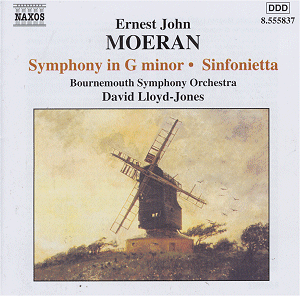Andrew Rose, The Worldwide Moeran Database (www.moeran.com).
If you are not already familiar with "Jack" Moeran's
unique soundworld then this Naxos disc (like the Maggini Quartet's superlative,
earlier chamber music recording on the
same label) is not a bad place to start, particularly as it features
a fine performance of what is, arguably, his masterpiece, the Symphony
in G minor. Existing Moeran aficionados will find that David Lloyd-Jones
and his Bournemouth players have set down versions of the two works
included, the Symphony and shorter, slighter Sinfonietta,
that can fully stand comparison (and indeed complement and illuminate)
the most recent versions, by Vernon Handley and the Ulster Orchestra
(Chandos), and Richard Hickox and the Northern Sinfonia (EMI), respectively.
As far as Lloyd-Jones is concerned, this recording also demonstrates
beyond doubt (if the Bax series alone was not enough) that, as a conductor
of British music, he is at least now up there with the aforementioned
Handley and Hickox.
Lloyd-Jones takes two minutes off the overall timing
of the Symphony, by comparison with the rival Handley version,
with only the Scherzo (slightly, by one second) slower. The overall
effect is of a lighter, more sprightly, but equally valid interpretation,
yet this may have more to do with the comparative weight of orchestral
sound, the recording and the venue than the timings. This also results,
to these ears anyway, in emphasising the kinship with a northern, Nordic
soundworld. The opening Allegro owes its inspiration to the wild,
western seaboard of the west coast of Ireland, in particular that of
County Kerry, and the gorgeous second subject brings echoes of the folk
music of that beautiful but severe landscape, where, in such places
as the Dingle peninsula, the mountains seem to descend straight into
the sea. Moeran related the second, predominantly slow movement (Lento),
to the countryside he was brought up in ("the sand dunes and marshes
of East Norfolk"). The brooding atmosphere brings to mind a torrential
summer downpour I experienced as a child on the remote Blakeney Point
in precisely that area. This section of the symphony has also been related,
by Moeran's biographer Geoffrey Self, to the bizarrely worded Norfolk
folksong The Shooting of His Dear. For those keen to pursue this
connection, the renowned English baritone Benjamin Luxon recorded a
totally idiomatic version (accents and all!) of Moeran's setting of
this song which is now available, at a bargain price (along with many
other brilliant folksong settings by Britten etc.) on Chandos (CHAN
6650). The beautiful Vivace has parallels with parts of Sibelius'
Symphony No. 6, evoking the interaction of rippling water and
sunlight (on an Irish lough?) superbly. Gravity returns, however, in
the finale, and, despite the temporary return of the Irish dance rhythms,
the piece ends ambiguously (Ives style?) without complete resolution.
The Sinfonietta is altogether a much lighter
piece and has been described as "neo-classical". For those who relate
this sobriquet to works by Stravinsky, Poulenc, Henze etc., this is
a less than useful description. Anyway, the piece is, by turns, a vigorous
and reflective response, according to Moeran himself, to the numerous
walks he took around the time of its composition, on the ridges and
bluffs that demarcate the southern end of the English-Welsh border (incorrectly
linked to Shropshire in the otherwise exemplary (and brilliantly informative)
notes by Lewis Foreman), when his parents retired to that area. It probably
goes without saying that the music is characteristically bracing but
it does also allow for moments of genuine and intuitive reflection,
particularly when it approximates to earlier British musical idioms.
The performance here is authoritative but I would exhort readers to
seek out Richard Hickox's EMI version (now removed from the catalogue
but still, I believe, widely available). Alongside an excellent version
of the Sinfonietta and the Delius/Warlock inspired Serenade,
this will also get you two of Finzi's minor masterpieces (The Fall
of the Leaf and Nocturne (New Year Music)). However,
this Naxos disc couples two vital works by this most under-rated of
composers and, to get the same works, in other couplings, is going to
cost you at least three times as much - even though Handley's Symphony
is now at mid-price on Chandos and Hickox's Sinfonietta can be
found for as little as £6. If you are greatly taken with the Symphony,
you may care to purchase Mike Dutton's restoration of Leslie Heward's
"white hot" premiere recording of it or sample some recent (amateur)
efforts, by the Shrewsbury Orchestra, offered, in mp3 format, at Andrew
Rose's aforementioned site, but we now have two great alternative interpretations
of a great British masterwork by two conductors who live and breathe
the music that came from (and continues to come from) "(on) this island"!
There is also, of course, the Penguin Guide Rosette winning Boult LP
(of the Symphony alone) that remains in the vaults of the musical black-hole
that Lyrita Records seems to have become, in the last two decades.
In conclusion, this is a disc of some great and too
little known British music, brilliantly and idiomatically played by
a great British (rather than London) orchestra and conducted by someone
who can do no wrong at present in his native repertoire. Buy it! You
cannot go wrong!
Neil Horner
See also review
by Rob Barnett and by
Jonathan Woolf


